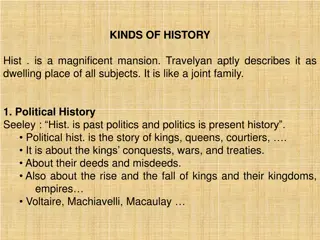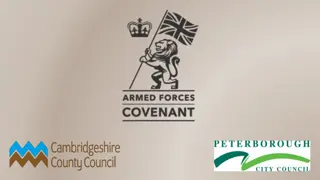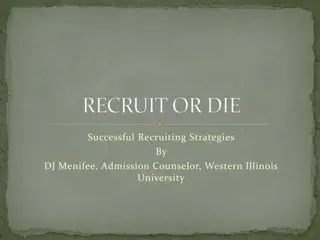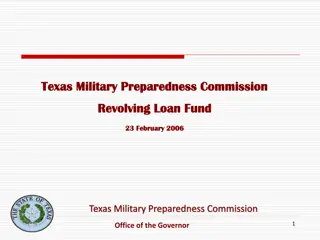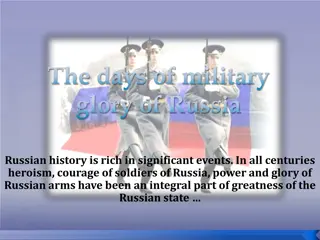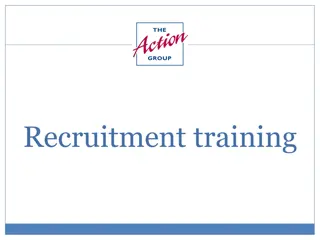Evolution of Recruitment and Training in Military History
The historical evolution of recruitment and training practices in military forces, from feudal levies and problems of recruitment to the establishment of standing armies and professional training regimens. Discover how the training of soldiers has evolved over centuries, adapting to changing warfare tactics and technologies.
Download Presentation

Please find below an Image/Link to download the presentation.
The content on the website is provided AS IS for your information and personal use only. It may not be sold, licensed, or shared on other websites without obtaining consent from the author.If you encounter any issues during the download, it is possible that the publisher has removed the file from their server.
You are allowed to download the files provided on this website for personal or commercial use, subject to the condition that they are used lawfully. All files are the property of their respective owners.
The content on the website is provided AS IS for your information and personal use only. It may not be sold, licensed, or shared on other websites without obtaining consent from the author.
E N D
Presentation Transcript
Recruitment Knights: Feudal levy Problems of recruitment: Unemployed, criminals, working men pressed into wars overseas 1914 1916 Military Service Act Assize of Arms: more after 1285 1757 Militia Act Scutage 1939 1645 New Model Army Royal Household The King s personal troops. About 4000 by 1300 1941 extended to women Cardwell s reforms 1870 Army Act 1948 Infantry: 1284 Edward I s Statute of Winchester 1871 Regularisation of the Forces Today 1337 first English army of paid troops 1500 1850 1250 Knights Tournaments: 1700 1900 Initially social attitudes held back improvements WWI Trained bands Muster Masters Better training for officers: 1645 New Model Army Infantry: longbow Today 1285 archery practice grounds 1363 Edward III practice on holidays Training
All 16-60 year old men had to muster once a year equipped for 40 days. Continued until 1645 1760 drums began to be used to help marching Criminals recruited into the army in wartime Death toll of trench warfare meant training was often rushed A standing army meant better training; musketeers and pikemen needed to learn to work together. All men with land had to provide and equip knights Kings relied on nobility to lead armies First professional standing army: 6600 volunteer cavalry on 24d a day, 1000 dragoons, 14,400 infantry (half pressed, half volunteer) on 8d a day Colonel s regiments: colonels were paid to set up new regiments to increase numbers often done on the cheap Charles II retained the standing army after 1660 but it was renewed every year National Service of 18 months for 17-21 year olds shield money pay a tax to pay for mercenaries rather than providing knights From 1850 at Sandhurst Military College 1871 sale of Commissions in the Army ended More professional army, paid for by taxes 1741 Woolwich Royal Military Academy for Artillery and Engineering officers More meritocratic. Officers were chosen for training and skills for the first time Training for weapons inspectors established at Hythe (1853) and Shoeburyness (1859) No organised training but knightly competition developed individual skills Reliance on volunteers: Kitchener s pal s battalions Ensured a constant supply of trained soldiers: signed up for 12 years (6 in army, 6 in reserve) Conscription Conscription Reorganised regiments into regions, each with 3 battalions. Also better rations and more humane treatment of soldiers. Basic training lasting 14 weeks, specialist training takes longer The King s personal troops. About 4000 by 1300 A portion of the men from each county s militia who met once a month in the summer to train Permanent volunteer standing army and Territorial Army, numbering around 150,000 Originally professional soldiers used to train the bands, but increasingly replaced by less-skilled local gentlemen became less effective Men aged 18-50 were selected to serve in the local militia for 5 years. Very unpopular, as could be sent overseas.
Recruitment Knights: Feudal levy Kings relied on nobility to lead armies Problems of recruitment: Criminals recruited into the army in wartime Colonel s regiments: colonels were paid to set up new regiments to increase numbers often done on the cheap 1757 Militia Act Men aged 18-50 were selected to serve in the local militia for 5 years. Very unpopular, as could be sent overseas. Cardwell s reforms 1870 Army Act Ensured a constant supply of trained soldiers: signed up for 12 years (6 in army, 6 in reserve) Reorganised regiments into regions, each with 3 battalions. Also better rations and more humane treatment of soldiers. 1871 Regularisation of the Forces Reorganised regiments into regions, each with 3 battalions. Also better rations and more humane treatment of soldiers. Unemployed, criminals, working men pressed into wars overseas More professional army, paid for by taxes 1914 Reliance on volunteers: Kitchener s pal s battalions 1916 Military Service Act conscription Assize of Arms: more after 1285 All men with land had to provide and equip knights Scutage shield money pay a tax to pay for mercenaries rather than providing knights Royal Household: King s own troops Infantry: 1284 Edward I s Statute of Winchester All 16-60 year old men had to muster once a year equipped for 40 days. Continued until 1645 1337 first English army of paid troops 1939 conscription 1941 extended to women 1645 New Model Army First professional standing army: 6600 volunteer cavalry on 24d a day, 1000 dragoons, 14,400 infantry (half pressed, half volunteer) on 8d a day 1948 National Service of 18 months for 17-21 year olds Today Permanent volunteer standing army and Territorial Army, numbering around 150,000 1500 1850 1250 Knights Tournaments: 1700 1900 Initially social attitudes held back improvements WWI Death toll of trench warfare meant training was often rushed Trained bands A portion of the men from each county s militia who met once a month in the summer to train Muster Masters Originally professional soldiers used to train the bands, but increasingly replaced by less-skilled local gentlemen became less effective 1645 New Model Army More meritocratic. Officers were chosen for training and skills for the first time. A standing army meant better training; musketeers and pikemen needed to learn to work together. Charles II retained the standing army after 1660 but it was renewed every year 1760 drums began to be used to help marching No organised training but knightly competition developed individual skills Better training for officers: 1741 Woolwich Royal Military Academy for Artillery and Engineering officers From 1850 at Sandhurst Military College Training for weapons inspectors established at Hythe (1853) and Shoeburyness (1859) Today Basic training lasting 14 weeks, specialist training takes longer Infantry: longbow 1285 archery practice grounds 1363 Edward III practice on holidays Training
Practice questions Practice questions 3. Explain one way in which the training of the army in 1250 was different from the training of the army in 1700 (4 marks) identify difference, then give an example from each time period to support. 5 or 6. The most important change in recruitment in the period 1800-2000 was the introduction of conscription in 1916. How far do you agree? You may use the following in your answer: Cardwell s Military Reforms, Military Service Act 1916, you must also use information of your own. Agree it was an important change in recruitment No, not that big a change, there were other important changes












